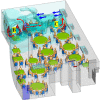Airborne transmission of COVID-19 virus in enclosed spaces: An overview of research methods
- PMID: 35762235
- PMCID: PMC9349854
- DOI: 10.1111/ina.13056
Airborne transmission of COVID-19 virus in enclosed spaces: An overview of research methods
Abstract
Since the outbreak of COVID-19 in December 2019, the severe acute respiratory syndrome coronavirus 2 (SARS CoV-2) has spread worldwide. This study summarized the transmission mechanisms of COVID-19 and their main influencing factors, such as airflow patterns, air temperature, relative humidity, and social distancing. The transmission characteristics in existing cases are providing more and more evidence that SARS CoV-2 can be transmitted through the air. This investigation reviewed probabilistic and deterministic research methods, such as the Wells-Riley equation, the dose-response model, the Monte-Carlo model, computational fluid dynamics (CFD) with the Eulerian method, CFD with the Lagrangian method, and the experimental approach, that have been used for studying the airborne transmission mechanism. The Wells-Riley equation and dose-response model are typically used for the assessment of the average infection risk. Only in combination with the Eulerian method or the Lagrangian method can these two methods obtain the spatial distribution of airborne particles' concentration and infection risk. In contrast with the Eulerian and Lagrangian methods, the Monte-Carlo model is suitable for studying the infection risk when the behavior of individuals is highly random. Although researchers tend to use numerical methods to study the airborne transmission mechanism of COVID-19, an experimental approach could often provide stronger evidence to prove the possibility of airborne transmission than a simple numerical model. All in all, the reviewed methods are helpful in the study of the airborne transmission mechanism of COVID-19 and epidemic prevention and control.
Keywords: Eulerian method; Lagrangian method; Monte-Carlo model; SARS CoV-2; Wells-Riley equation; airborne transmission; dose-response model; experimental approach; ventilation.
© 2022 John Wiley & Sons A/S. Published by John Wiley & Sons Ltd.
Figures





References
-
- WHO . Novel coronavirus (2019‐nCoV) situation report. 2020. Accessed July 10, 2020. https://www.who.int/docs/default‐source/coronaviruse/situation‐reports/2...
Publication types
MeSH terms
LinkOut - more resources
Full Text Sources
Medical
Miscellaneous

